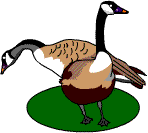Canada Geese
Created | Updated Aug 3, 2005

The Canada Goose1 is a species of large aquatic bird. They are, characteristically, chocolate brown with black heads and white cheeks. However, there are estimated to be over forty sub-species; and interbreeding with domestic geese is common. The largest, called 'Honkers', may weigh up to 8kg, and have a wingspan of 2m.
Habitat
Native to marshland and river estuaries, the versatile Canada Goose is now common anywhere there is a reasonably large body of water, including urban parkland. Once reliant on sedge and reeds for nest sites, they are now completely at ease in a man-made environment and may nest anywhere they find a modicum of cover... often to the chagrin of gardeners.
Diet
In the wild, they are exclusively vegetarian, feeding mainly on aquatic plants. In the urban environment the main component of their diet is turf grass but they will eat almost anything they are offered, including bread, grain, or flower beds.
Of Geese and Men
Canada geese share the same tastes, ambitions, and sensibilities as human beings. Both exist in greater numbers than ever before. Both love park land to death.
Canada Geese are so overwhelmingly human in all but their ability to fly, bob effortlessly on the surface of water, and subsist on a diet of grass, that it is often speculated that Canada Geese are the reincarnated souls of beings who have transcended the human limit of raucous bickering.
Reproduction
Canada Geese mate for life. Each pair will raise one clutch of young per year. A nest may contain from four to ten eggs. Incubation, by the female, takes about 28 days. The growth rate of their young is astonishing! A baby goose may be heard 'peeping' eight or ten hours before it shows any sign of hatching. Once hatched, it is a slimy, wobbly thing only a mother goose could love, unable to support its own weight. Within a few hours the slimy mound of proto-bird will have been transformed into an adorable fluff ball, running, jumping, and peeping incessantly. Adult birds moult during the mating period and become, during this time, as Earth bound as their young for approximately five weeks.
Migration
Every autumn in North America, enormous flocks of Canada Geese may be seen heading south in advance of the approaching winter, while, on the ground far below, many of their human counterparts may be observed doing the same. Wave after wave of regular 'V'-formations fill the autumn skies. The drive to escape the bitter cold of the far north is due more to the scarcity of food than to the sub-zero temperatures. In places where food remains plentiful, such as urban areas, Geese often learn that the annual southern trek is not really necessary. They are quite content to bob about on partially frozen lakes, as long as there is plenty to eat. Stop-at-home geese are more likely to fall victim to foxes, coyotes, and wolves, though, emboldened by the scarcity of easier prey, than to the winter weather.
The Urban Goose
In many urban centres, there are so many Canada Geese that they are becoming a problem. They are naturally attracted to park land, especially that which is near a body of water. They feed almost non-stop on turf grass, which they may completely destroy, or handouts from people. Naturally, the amount of faeces they produce is directly proportional to the amount they eat. This unfortunate side effect may result in lawns and pathways unfit for human use. Canada Geese soon grow complacent about traffic. They frequently work out routes which typically involve walking back and forth across busy roads, with inevitably tragic consequences.
In addition, they are often fiercely protective of their nests or young2. A belligerent adult Canada Goose can be dangerous. As they mature, a callous-like 'knuckle' develops at the 'elbow' of the wing. This is a formidable weapon on older birds. They are quite capable of beating a grown man senseless. Particular care should be taken when small children are present, especially near water.
How to Cook your Goose
Thoroughly wash your dressed goose.
Stuff cavity with apples, prunes and onions.
Place in a deep roasting pan, preferably with a grease drain.
Cover and roast at a moderate heat (350°F, 180°C) for about three and a half hours3.

